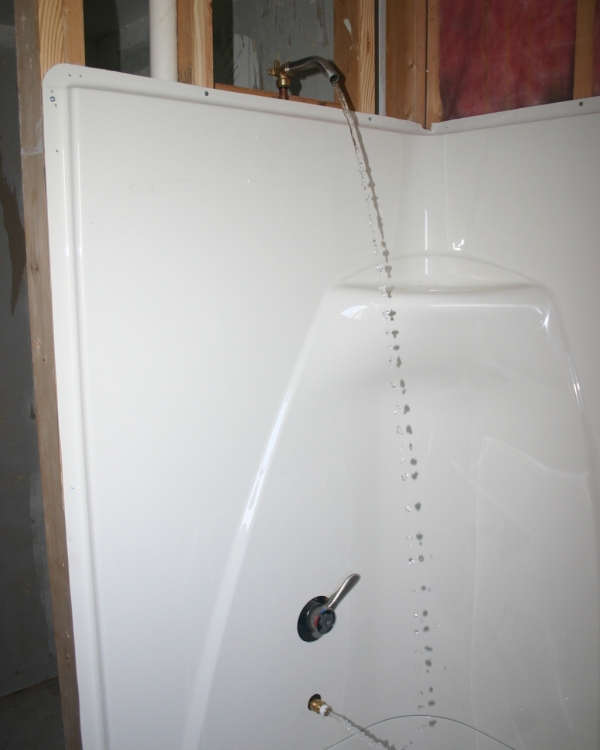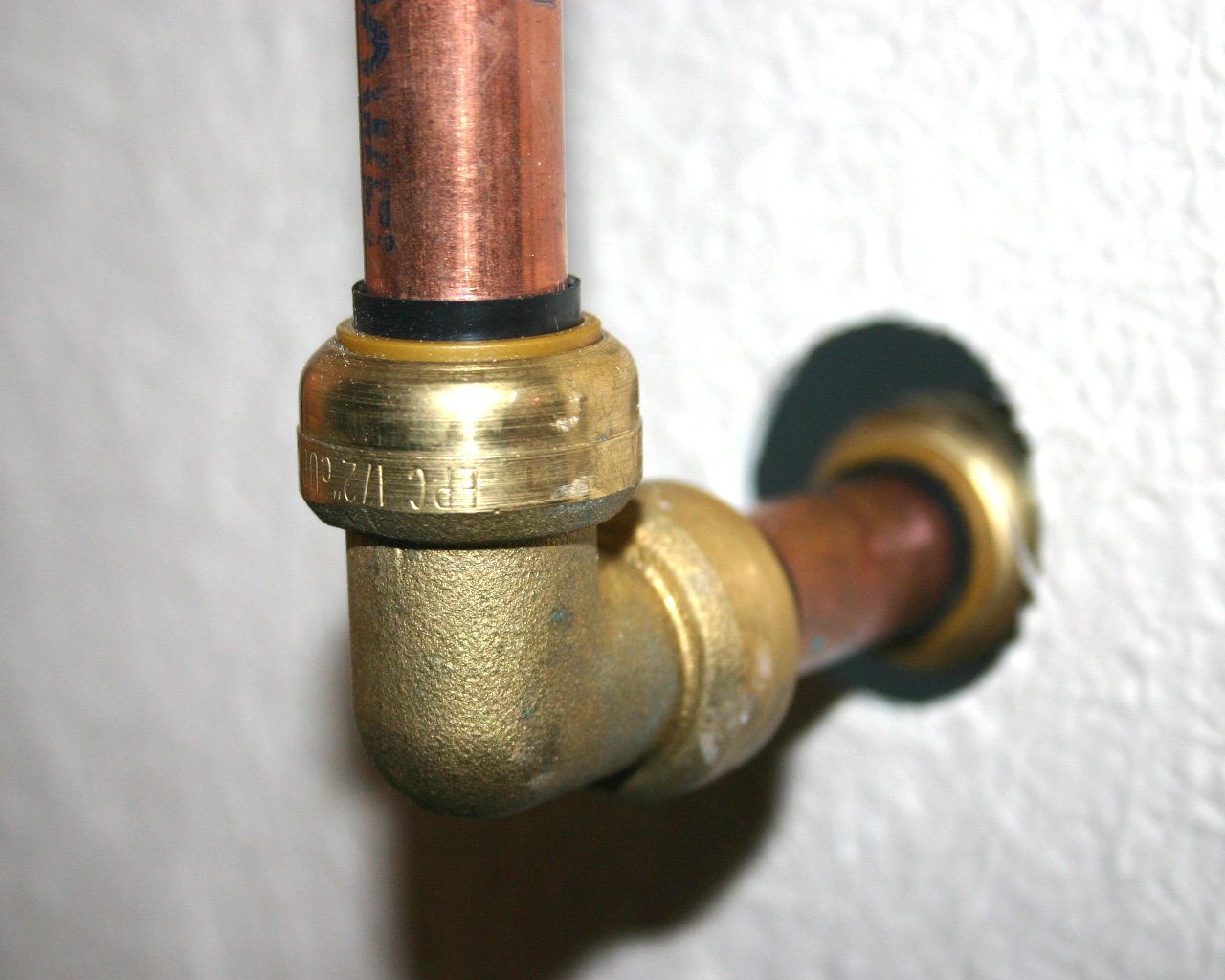Shower Rise
Problems can occur with any type of renovation project. Prior to installing our new three piece acrylic bathtub and surround, we determined that the existing locations of both the shower arm and tub spout were too low. While we had hoped to keep the existing plumbing intact, we realized that we would need to redo the rough plumbing to relocate the shower arm and tub spout.
Since our house already had copper plumbing pipes, we decided to replace the existing tub and shower pipes with copper, rather than PEX or CPVC. Even though I have done some plumbing in the past, I had reservations about soldering the copper piping and fittings.

We considered calling a plumber; however, that would add even more cost to our ever increasing project budget. After visiting our local home improvement store, I learned about push fittings for copper plumbing pipes. I felt this was a good solution and resolved my concerns, since soldering is not required when using push fittings.
 First, I shut off the water supply to the house and installed shutoff valves at both the hot and cold water supply pipes. This enabled me to shut off the water supply at the location of the tub and shower while keeping the water on for the rest of the house. I installed the rough-in plumbing for the shower arm and tub spout after installing the rough-in valve body (mixes hot and cold water to achieve a set temperature prior to delivery), which was located and installed according to both the fixture manufacturer's installation instructions and the new bathtub and surround manufacturer's guidelines.
First, I shut off the water supply to the house and installed shutoff valves at both the hot and cold water supply pipes. This enabled me to shut off the water supply at the location of the tub and shower while keeping the water on for the rest of the house. I installed the rough-in plumbing for the shower arm and tub spout after installing the rough-in valve body (mixes hot and cold water to achieve a set temperature prior to delivery), which was located and installed according to both the fixture manufacturer's installation instructions and the new bathtub and surround manufacturer's guidelines.
After the rough plumbing was completed, I installed the new bathtub and surround. In order to test the plumbing, I decided to temporarily install the finished tub and shower fixtures. Against my better judgment, I announced over family dinner that I needed to turn on the water to ensure all was working correctly. My daughters were getting excited at this point in the renovation project; progress was visible and our oldest daughter convincingly established her desire to be the first to turn on the water to "her" new tub and shower. I obliged, having little reservation; what could go wrong...
She and I promptly went upstairs and turned the valve lever for the bathtub to the 'on' position. Successfully, water flowed from the tub spout. My daughter then pulled up the shower diverter, and voila, water flowed from the shower arm. Full of questions and delight, my 5 year old was impressed, to say the least. We turned it on and off, checked for leaks, etc. With the shower diverter down, we adjusted the temperature knob to its midpoint between hot and cold. To my surprise, water flowed from both the tub spout and then slowly from the shower arm. I stared at the outcome, confused, while my daughter thought it was cool. I was unimpressed, unsure how this could have happened and what I could do to fix what was obviously a problem. I had to disappoint my 5 year old when she wanted to know when she could take a bath in her new tub.
In order to determine a solution, I contacted the fixture manufacturer, fixture supplier, and a plumber. The plumber inquired if the rough-in valve body was installed upside down, which evidently happens quite often, despite the body indicating "UP". Thankfully, I had installed it properly. When I spoke to the fixture supplier, they were unaware of what could cause the issue other than a defective spout and/or a defective mixing cartridge. They suggested I get those replacement parts from the manufacturer. The manufacturer, as one would guess, has experienced the very same issue more often than most, and wasn't about to send me any unnecessary replacement parts. After answering a series of questions about the installation, the fixture manufacturer determined that I was experiencing a problem called “shower rise.”
 Shower rise occurs when water flow is restricted within in the plumbing, backs up, and escapes through the shower arm or head. Having answered the manufacturer's questions, all of which related to the installation instructions, it was determined that I used the proper copper plumbing pipes; the rough-in valve body was properly installed; there was only one 90-degree fitting, which is proper; and the tub spout drop pipe was within the recommended 8” to 18” drop (the distance between the rough-in valve body and tub spout). The manufacturer indicated two possibilities that could be causing the problem: something, maybe debris, was impeding the flow of water, and/or the push fittings I used in the tub spout drop pipe were restricting the flow of water. Having already flushed and back flushed the assembly, my frustration was now focused on the simple fact that I would have to remove the drywall on the backside of the wall (I had performed all the plumbing work from the bathroom side) in order to access the tub spout drop pipe and make the necessary repairs. To be honest, I was also a little frustrated with the manufacturer. Their installation instructions state "Do not use PEX tubing for tub spout drop” and make no mention of push fittings being restricted, which would have helped to prevent this.
Shower rise occurs when water flow is restricted within in the plumbing, backs up, and escapes through the shower arm or head. Having answered the manufacturer's questions, all of which related to the installation instructions, it was determined that I used the proper copper plumbing pipes; the rough-in valve body was properly installed; there was only one 90-degree fitting, which is proper; and the tub spout drop pipe was within the recommended 8” to 18” drop (the distance between the rough-in valve body and tub spout). The manufacturer indicated two possibilities that could be causing the problem: something, maybe debris, was impeding the flow of water, and/or the push fittings I used in the tub spout drop pipe were restricting the flow of water. Having already flushed and back flushed the assembly, my frustration was now focused on the simple fact that I would have to remove the drywall on the backside of the wall (I had performed all the plumbing work from the bathroom side) in order to access the tub spout drop pipe and make the necessary repairs. To be honest, I was also a little frustrated with the manufacturer. Their installation instructions state "Do not use PEX tubing for tub spout drop” and make no mention of push fittings being restricted, which would have helped to prevent this.
 I visited with a home improvement store salesman and contacted the plumber and supplier to see if they had ever experienced shower rise with push fittings before. To my dismay, no one had. Reluctantly, I removed the drywall and decided to remove each piece and fitting of the assembly to determine for myself where the problem was occurring. I removed the tub spout, the spout adapter, a threaded push fitting, some copper pipe, and the 90-degree push fitting. Shower rise no longer occurred. Water only flowed down the copper pipe which was connected to the rough-in valve body with a threaded push fitting. At this point in the process, I agreed with the manufacturer, and decided to solder copper pipe and a 90-degree fitting in lieu of the 90-degree push fitting for the tub spout drop. Once complete, all tub and shower fixtures performed as expected.
I visited with a home improvement store salesman and contacted the plumber and supplier to see if they had ever experienced shower rise with push fittings before. To my dismay, no one had. Reluctantly, I removed the drywall and decided to remove each piece and fitting of the assembly to determine for myself where the problem was occurring. I removed the tub spout, the spout adapter, a threaded push fitting, some copper pipe, and the 90-degree push fitting. Shower rise no longer occurred. Water only flowed down the copper pipe which was connected to the rough-in valve body with a threaded push fitting. At this point in the process, I agreed with the manufacturer, and decided to solder copper pipe and a 90-degree fitting in lieu of the 90-degree push fitting for the tub spout drop. Once complete, all tub and shower fixtures performed as expected.
My general lack of confidence in soldering copper pipe, in addition to my lack of understanding of push fittings, is essentially what allowed the problem to occur. Based on my conversations, though, I know I am not alone. What I have since come to realize through product research is that push fittings, which were originally designed for use with PEX tubing, have a PEX tube support or stiffener liner within. This liner isn't required and can be removed when used with CPVC or copper pipe. My thought is that the tube liner reduces the interior diameter of the copper piping, restricting water flow with increased hot and cold water pressure. If the liner is removed when used with copper piping, is water flow restricted in the tub spout drop pipe assembly causing shower rise, or does it flow freely through the 90-degree push fitting? Unfortunately, I am unable to answer this question, but will put it out there for anybody willing to try. It is my hope that the manufacturers of these products will continue to work together to improve the assembly and to better communicate this within their installation instructions.

Jeff Calcamuggio
Jeff is an Editor-at-Large for Buildipedia.com who writes and edits Featured At Home and Knowledgebase content. Prior to joining Buildipedia, Jeff's work experience included carpentry, construction documentation, specification writing, construction administration, project management, and real estate property inspection. Jeff is a member of the Construction Specifications Institute (CSI) and an educator at Columbus State Community College and enjoys challenging DIY home improvement projects.

